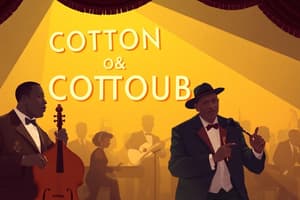Podcast
Questions and Answers
The narrative is delivered from a first-person perspective, providing intimate insights into the characters.
The narrative is delivered from a first-person perspective, providing intimate insights into the characters.
False (B)
What historical era is portrayed in the story?
What historical era is portrayed in the story?
The antebellum period in Louisiana.
Study Notes
Racial Dynamics
- Explores themes of racial identity and prejudice in the antebellum South.
- Désirée's heritage is questioned, reflecting societal views on race.
- The baby’s ambiguous racial identity challenges notions of pure bloodlines.
- Armand's racism leads to tragic consequences, revealing hypocrisy in his views.
Narrative Structure
- The story unfolds in a linear progression, with a clear beginning, middle, and end.
- It utilizes foreshadowing to hint at the eventual revelation of racial identity.
- The climax occurs when Désirée confronts Armand about their child's race.
Character Analysis
- Désirée: A complex character; her identity is tied to her husband and child. Her journey reflects vulnerability and resilience.
- Armand Aubigny: Represents toxic masculinity and deep-seated racism. His pride leads to his downfall when he discovers his own mixed heritage.
- Madame Valmonde: Acts as a maternal figure; her acceptance of Désirée contrasts with Armand’s rejection.
Narrator Type
- Third-person omniscient narrator offers insights into characters' thoughts and emotions.
- Provides a detached perspective, allowing readers to observe racial tensions and personal conflicts.
Genre
- Southern Gothic: Features dark themes, moral ambiguity, and complex characters typical of the genre.
- Emphasizes social issues, particularly concerning race and identity in a historical context.
Resolution Type
- Ironical resolution; the ending reveals the true nature of Armand's lineage.
- Highlights the tragic consequences of racism and the illusion of racial superiority.
Narrative Time
- The story is set in the 19th century, reflecting the historical context of slavery and racial inequality.
- Time unfolds in a straightforward manner, focusing on key events that reveal character motivations and societal norms.
Racial Dynamics
- Examines racial identity and prejudice prevalent in the antebellum South.
- Désirée’s lineage becomes a focal point, showcasing societal attitudes towards race.
- The child's unclear racial identity disrupts conventional ideas of pure bloodlines and heritage.
- Armand’s deep-seated racism culminates in tragic outcomes, exposing the contradiction in his belief system.
Narrative Structure
- Structured with a linear progression, consisting of a clear beginning, middle, and conclusion.
- Utilizes foreshadowing techniques to hint at forthcoming revelations regarding racial identity.
- The climax centers on Désirée's confrontation with Armand concerning their child's heritage.
Character Analysis
- Désirée: A nuanced character whose identity is intricately linked to her family, embodying vulnerability and strength throughout her journey.
- Armand Aubigny: Symbolizes toxic masculinity intertwined with profound racism; his arrogance leads to a tragic self-discovery about his own mixed lineage.
- Madame Valmonde: Serves as a nurturing figure whose acceptance of Désirée contrasts sharply with Armand’s harsh rejection.
Narrator Type
- Employs a third-person omniscient narrator, providing a window into characters' internal thoughts and feelings.
- Offers a detached viewpoint enabling readers to grasp racial tensions and personal struggles more fully.
Genre
- Classified as Southern Gothic, showcasing dark themes, moral uncertainties, and complex characterizations emblematic of the genre.
- Focuses on social issues, particularly relating to race and identity against a historical backdrop.
Resolution Type
- Features an ironic resolution, revealing Armand's true heritage and lineage.
- Illustrates the tragic repercussions of racism and challenges the myth of racial superiority.
Narrative Time
- Set in the 19th century, reflecting the historical context of slavery and persistent racial inequalities.
- Time is presented in a straightforward manner, emphasizing key moments that uncover character motivations and societal values.
Narrator Type
- First-Person Limited narration provides a direct window into Armand Aubigny's inner thoughts and emotional struggles.
- The narrator is unreliable due to his lack of awareness regarding his own mixed heritage, resulting in notable tension and ironic situations.
Genre
- Classified as a Short Story, presenting a focused narrative that delves into themes with depth despite limited length.
- Falls under Realism, accurately portraying societal issues, particularly the complexities surrounding race and identity in a historical context.
- Incorporates Gothic Elements, emphasizing themes of isolation and psychological distress, significantly illustrated through Armand's character arc.
Resolution Type
- Features a Tragic Resolution, culminating in a surprising twist where Armand uncovers his hidden ancestry, ultimately leading to his tragic downfall.
- Employs Irony in its conclusion, highlighting the harsh contradiction between Armand's racist beliefs and the true nature of his lineage, where he stands as someone he considers inferior.
Narrative Time
- Adopts a Linear Timeline, with a straightforward chronological progression from Désirée’s arrival to the climactic revelation of Armand's ancestry.
- Includes Flashbacks that provide essential background and context, enhancing understanding of characters, particularly concerning Désirée's past.
Character Analysis
- Désirée: A woman with uncertain racial background, grapples with her identity and societal expectations. Her profound love for Armand highlights her devotion and vulnerability.
- Armand Aubigny: A plantation owner epitomizing pride and masculinity. His fixation on racial purity leads to tragedy, revealing his inner prejudices and insecurities.
- La Blanche: Désirée's mother who symbolizes the intricate nature of race and heritage. Her lineage is crucial to the overarching themes of the narrative.
- The Baby: Acts as a focal point for racial identity conflict; the child’s implications are central to the story's unfolding drama.
Narrative Structure
- Exposition: Establishes the relationship between Désirée and Armand, set against the backdrop of antebellum Louisiana.
- Rising Action: Heightened tension arises as Désirée begins to question her child's heritage, noticing distinct physical traits.
- Climax: The pivotal moment of the baby's racial revelation disrupts Désirée and Armand’s marriage.
- Falling Action: Désirée's despair escalates, leading to tragic choices that emphasize emotional conflict.
- Resolution: A twist ending uncovers Armand's true heritage, highlighting the irony ingrained in his prejudices.
Symbolism and Setting
- Setting: The plantation life of antebellum Louisiana underscores social hierarchies and racial strife prevalent during the period.
- Symbolism:
- The Bayou: Represents the unknown complexities surrounding identity and lineage.
- Fire: Embodies destruction and the all-consuming nature of Armand's pride and prejudice.
- Désirée's Clothing: Initially symbolizes innocence, later reflecting her transition to despair.
Narrator Type
- Third-person Limited Narrator: Primarily conveys Désirée's emotional experience, offering insights into her journey while maintaining a degree of detachment from other characters' perspectives.
Genre
- Gothic Fiction: Infused with mystery and emotional depth, it explores themes of isolation and identity.
- Social Commentary: Provides critique on the rigid societal norms regarding race and gender in the antebellum era.
Resolution Type
- Irony: The conclusion is steeped in irony, as Armand, who rejects Désirée and their child for perceived impure lineage, discovers he himself has mixed heritage.
Narrative Time
- Chronological: Events unfold in a linear fashion, detailing the progression from courtship to the story's conclusion.
- Flashback Elements: Character dialogues and reflections reveal backstories, enriching the understanding of motivations and social context.
Studying That Suits You
Use AI to generate personalized quizzes and flashcards to suit your learning preferences.
Description
Explore the themes of racial identity and prejudice in the antebellum South through the lens of the short story 'Désirée's Baby'. Analyze key characters like Désirée and Armand, their complex relationships, and the societal implications of their actions. This quiz will challenge your understanding of narrative structure and character analysis in the context of racial dynamics.




